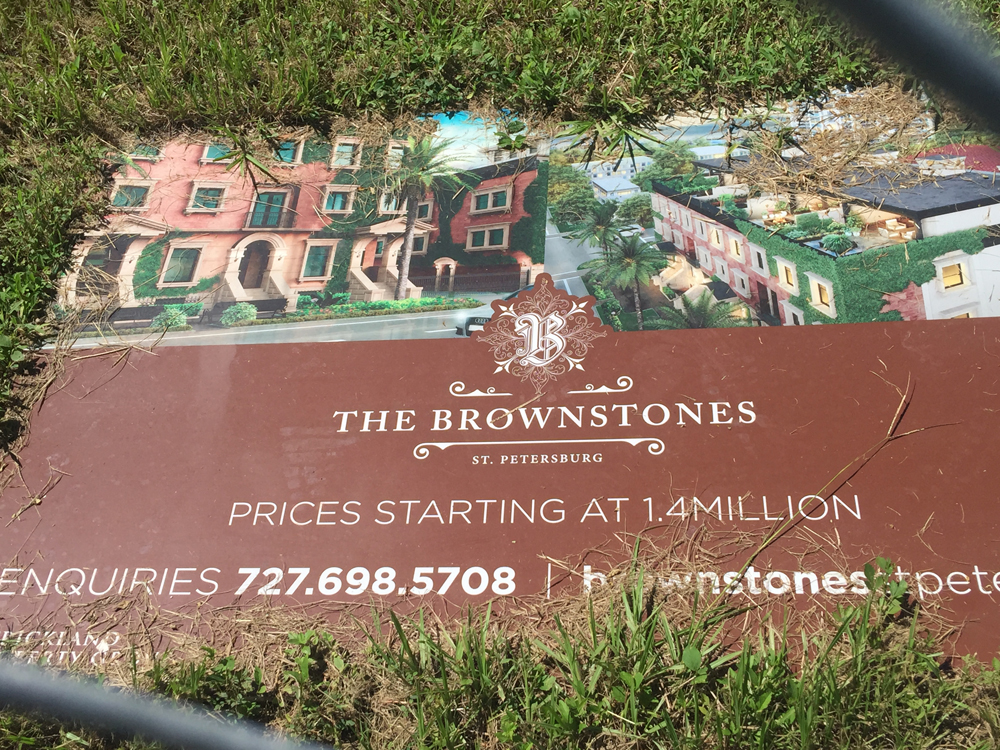Recent debate over plans for a 10,000 square foot lot at 4th Avenue N and 1st Street illustrates the current frenzy and likely future trends concerning downtown St. Petersburg apartment development.
A 19-story condo tower named Bezu has been approved for that intersection’s southwest corner. The city’s Development Review Commission approved the plan by a 4-3 vote in June and on August 2 the city council denied an appeal with a 4-4 vote after a contentious 5-hour hearing. The project has the green light, pending downtown development plan review and possible legal action by opponents. The current Bezu design is scaled down from an earlier 23-story plan that was denied. The new Bezu still faced energized resistance based largely on its size, proximity to neighboring apartments, and the lack of setback of the 180-foot tall façade from the 4th Ave. N sidewalk. The approved plan includes a slender 15-story tower sitting on top of a 4-story base. The 120-foot wide, 35-foot deep tower includes 20 residential units. The base, occupying the majority of the property’s area, will include 36 parking spaces with car access to the upper parking levels by elevator. The base is 16 feet from the Flori de Leon apartment property to the west and 7.5 feet from Spanish Palms apartments to the south. The balconies are on the south side of the building, taking advantage of the view toward the Skyway bridge, leaving the northern 4th Ave. N side of the building relatively sheer along the sidewalk.

The approved Bezu plan follows several designs for the property in recent years:
- A 13-story condo tower was approved in 2005.
- An 11-story project was proposed in 2012.
- Brooklyn-style brownstones were promoted in 2015 but just one came under contract.
- Last year the original Bezu design was unanimously rejected by the DRC.
Owners First and Fourth Development, LLC and its agent Michel Regignano submitted the current design earlier this year. Since 2005 the property has been sold for increasing amounts 3 times, most recently for $3 million this March. Construction cost for Bezu was estimated at $11 million.
At the city council hearing about 30 Flori De Leon and other neighborhood residents testified against the tower plans. More than 1,500 people had contacted the city council to oppose Bezu before the meeting. Defending against the appeal were the developers and their legal, sales and architectural representatives as well as Chamber of Commerce and DRC staff. The staff report noted compliance with 17 considerations from the City Code (Chapter 16), which guided the DRC’s approval. Testimony from opponents at the council meeting maintained that, while subjective viewpoints come into play, several of the considerations had not been fully met. The harmony and compatibility with adjacent and neighborhood properties and sufficiency of land area as well as impact on St. Petersburg’s highly rated walkability were questioned.
Preserve The Burg’s Peter Belmont focused on the importance of neighborhood compatibility standards and cited a court case on a nearby lot 10 years earlier as a precedent. William Herrmann, a Flori de Leon resident who spearheaded the opposition, stressed that it should remain enjoyable to walk around the neighborhood and presented renderings of the Bezu looming over the sidewalk. Robin Reed, an Old Northeast resident and historic preservation volunteer, noted that many speaking at the meeting had moved here because of St. Petersburg’s quality of life, which can be supported if buildings fit with the size of their lots.
The building qualified for a Floor Area Ratio (FAR), the floor area divided by the 10,000 square foot lot area, of 5.0. The Bezu application was granted a bonus of 2.0 FAR above the 3.0 downtown district baseline due to artwork added facing the public and screening of parking garage areas. The FAR calculation and design enhancements will be reviewed by the city prior to the release of permits.

City staff listed several tall apartment buildings within a couple blocks circumference and also pointed out that when it was built in the 1920’s the historically designated 7-story Flori de Leon (then the spring training residence of Yankee sluggers Babe Ruth and Lou Gehrig) dwarfed its neighbors. The staff also emphasized that the current Bezu design reduced the building height to 180 feet from the previous design’s 300 feet and that the distance from the Flori de Leon property had been increased from 7 to 16 feet.
Todd Pressman, representing the developers, described the Bezu plan as “5 pounds of sugar in an 8-pound bag.” This view prevailed for Bezu. After the hearing Lisa Brock, a communications representative for the Bezu developer, indicated that further information about the project would be available shortly.
Will compatibility issues involving setbacks and scale play a large role in future approvals? City Councilman Charles Gerdes stated, “If we want to change what the vision of our downtown is we need to change the land use code.” Herrmann, contacted after the meeting, shared Belmont’s view that the current code supports a vision that would oppose Bezu including appropriate setbacks to reinforce the pedestrian feel at the street and the charm that distinguishes St. Petersburg from other larger cities. Steven Seibert, a former Pinellas County commissioner who moved to a nearby 2-story condominium last year, stated that the Bezu decision may lead to a “future in downtown of concrete canyons.” Reached later, he pointed to other recent apartment tower announcements with the concern that, “Bezu sets the baseline now. All can point to it.”
Seibert, however, notes the closeness of the DRC and city council votes, “A small vote change in either meeting would have resulted in a different decision. That reflects a lack of a consistent vision for downtown. We need to plan more thoughtfully for the next 50 years.”
The only certainty is that the strong pace of downtown development will continue at least in the short-term.
See stpeterising.com for a summary of active projects.



